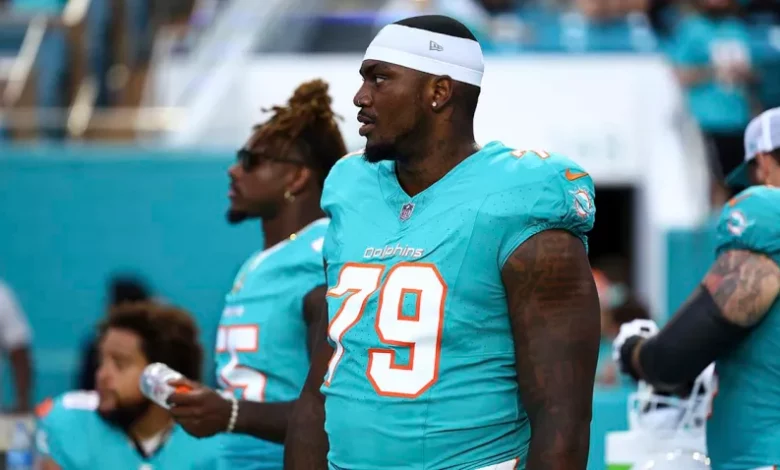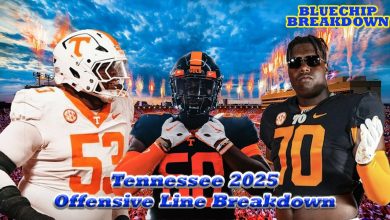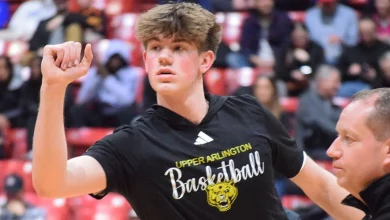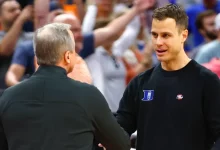Following a collision during practice, Miami Dolphins’ player Bayron Matos successfully recovered full movement, demonstrating resilience and effective medical care after initial concerns about his injury.

In the high-stakes environment of the National Football League (NFL), players constantly push their physical and mental boundaries, risking injuries that can threaten their careers and well-being. The story of Miami Dolphins’ defensive end, Bayron Matos, exemplifies resilience and the importance of effective medical intervention when faced with such adversity. During a routine practice session, Matos was involved in a collision that initially raised concerns about his health. However, through swift medical response, comprehensive evaluation, and unwavering determination, he managed to recover full movement, showcasing not only his physical resilience but also the critical role of medical teams in athlete recovery. This narrative delves into the details of that incident, the immediate response, the recovery journey, and the broader implications for player safety and mental toughness in professional football.
The Practice Incident: A Moment of Uncertainty
The Miami Dolphins’ training camp is a rigorous environment where players hone their skills, build team chemistry, and prepare for the demanding NFL season. During one such session, Bayron Matos was engaged in a drill designed to simulate game situations, focusing on pass rushing, containment, and tackling. These drills are intense, emphasizing quick reactions and physical contact, inherently carrying risks of injury.
In a particular moment, Matos collided with another player during a block, resulting in a hard fall. Witnesses recall that the collision was forceful, with Matos hitting the ground awkwardly, immediately prompting concern among coaches, teammates, and medical staff. Such incidents, though common in football, often spark anxiety because of the sport’s physicality and the potential for serious injury, especially when the player’s head or neck is involved.
The immediate reactions on the field were swift. Trainers rushed to his side, assessing responsiveness and signs of distress. Matos appeared conscious, but visibly shaken, with a grimace of pain. Recognizing the potential severity of the collision—particularly the risk of neck or spinal injuries—the medical team followed established protocols to ensure his safety.
Emergency Response and Medical Evaluation
Given the nature of the collision, the medical staff prioritized immobilization and precautionary measures. They immobilized Matos’ neck and back to prevent any additional injury, and a decision was made to transport him to a hospital for comprehensive evaluation. An ambulance was called, and in a testament to the team’s commitment to player safety, a helicopter was dispatched to expedite his transfer.
This rapid response was crucial. In NFL injuries involving potential spinal or head trauma, time is of the essence. The helicopter ride, brief yet tense, allowed for swift access to advanced medical facilities, where specialists could conduct detailed assessments. During the transfer, team officials and medical personnel maintained communication, ensuring that Matos was stable and comfortable.
Once at the hospital, a thorough examination ensued. This involved neurological assessments, physical examinations, and imaging scans—such as MRI and CT—to rule out fractures, ligament tears, nerve damage, or brain trauma. The medical team’s goal was to determine whether there was any structural damage that could threaten his health or career.
The Diagnosis: No Structural Damage, Full Motor Function
After detailed analysis, the results were encouraging. The scans indicated no fractures, ligament tears, or spinal cord injuries. The injury appeared to be soft tissue-related—muscle strains and minor contusions. Importantly, the neurological assessment confirmed that Matos retained full motor function: he could move all extremities, and sensation was intact.
This was a critical milestone. In cases of potential spinal injury, the preservation of movement and sensation often means that the injury is less severe than initially feared. It also meant that, with proper care, Matos could expect a full recovery without long-term impairments.
The Road to Recovery: Rest, Rehabilitation, and Mental Resilience
Following diagnosis, the medical team outlined a recovery plan emphasizing rest, gradual physical rehabilitation, and mental health support. The initial phase involved rest to allow inflammation to subside, along with pain management strategies. The importance of patience was stressed—rushing back too soon could risk aggravating the injury.
Physical therapy played a vital role. Under the supervision of sports medicine professionals, Matos engaged in controlled exercises designed to restore flexibility, strength, and confidence in his body. The therapy sessions focused on core stability, neck and back strengthening, and mobility exercises, ensuring that he regained full control and range of motion.
Throughout this process, Matos demonstrated remarkable resilience. His mental toughness was tested as he navigated the uncertainty of injuries, the frustration of being sidelined, and the desire to return to full health. Support from teammates, coaches, family, and mental health professionals helped him maintain a positive outlook, reinforcing his commitment to recovery.
The Significance of Full Movement Recovery
Achieving full movement was a pivotal milestone in Matos’ recovery journey. It signified that he had avoided severe neurological damage and that his body responded well to treatment. For an athlete, this outcome is not just about physical capability but also about psychological confidence—trusting that his body is capable of performing at the highest level again.
In football, where explosive movements, quick cuts, and physical contact are routine, confidence in one’s mobility and strength is essential. Matos’ full recovery restored his self-assurance, enabling him to approach training and upcoming games with optimism.
Broader Implications: Player Safety and Medical Excellence
This incident underscores the NFL’s ongoing commitment to player safety. Modern medical protocols, rapid emergency response, and advanced imaging technology are critical in managing injuries effectively. The Dolphins’ prompt action, including the decision to deploy a helicopter, exemplifies best practices in sports medicine.
Moreover, the incident highlights the importance of comprehensive injury management not solely for physical recovery but also for mental well-being. Athletes often face psychological hurdles after injuries—fear of re-injury, loss of confidence, or anxiety about performance. Support systems, including mental health professionals and peer encouragement, are essential components of a successful comeback.
The Return to Play and Future Outlook
Following a period of structured rehabilitation, Matos received medical clearance to return to practice. His reintegration into team drills was cautious and carefully monitored, ensuring no setbacks occurred. His performance in subsequent practices reflected regained confidence, agility, and strength.
His journey from injury to full movement served as an inspiring example for teammates and fans alike. It reinforced the message that resilience, combined with timely medical intervention and support, can turn adversity into an opportunity for growth.
Personal and Team Lessons
For Matos personally, this experience reinforced the importance of listening to his body, adhering to medical advice, and maintaining mental resilience. It demonstrated that setbacks are part of athletic careers but can be overcome with perseverance and proper care.
For the Dolphins and the broader NFL community, it was a reminder of the critical role of medical preparedness, safety protocols, and mental health support in athlete well-being. The incident fostered a culture emphasizing safety, recovery, and resilience—values vital for long-term success.
A Triumph of Resilience and Medical Care
Bayron Matos’ recovery story exemplifies the resilience of an athlete faced with adversity and the efficacy of professional medical intervention. From the initial shock of a collision during practice to the triumphant return with full movement and confidence, his journey underscores the importance of swift medical response, comprehensive care, mental toughness, and team support. It serves as a powerful reminder that in the demanding world of professional football, injuries—while inevitable—can be managed effectively, enabling players to emerge stronger and more determined. As Matos continues his career, his experience stands as a testament to perseverance, medical excellence, and the indomitable spirit that defines sports at its highest level.









